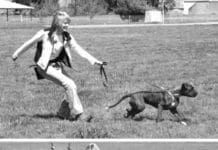Training a Dog to Make Choices
One would expect that the rise of force-free training methods and the increased awareness of and respect for dogs as sentient creatures would make life easier for them. We should expect to see a corresponding rise in the number of calm, stable, well-adjusted dogs who are happily integrated into lifelong loving homes. But many training and behavior professionals note with alarm the large number of dogs in today's world who seem to have significant issues with stress and anxiety, with high levels of arousal and low impulse control.
Doggy Inside Jokes: The Unconventional Cues Our Dogs Learn
which means to stop his attempts to be noticed and petted.üTo teach her dog Trixie to enjoy coming back into the house (as an alternative to continuing to play outside), Valerie Balwanz initially used treats as a lure, and gave the behavior its own name: Inside
Training Your Dog to Learn
Operant conditioning and classical conditioning, though mostly applied to human psychology nowadays, are structures that were first developed in observing dog behavior. They are somewhat opposite methods of behavioral modification, however both are effective in training animals (and young children). They work simply to reverse bad habits and teach good ones. Read on to learn the difference, and get your dog obeying all your commands, every time.
Train Your Dog Using Imitation
I remember, years ago, confidently and assertively telling my training academy students "Dogs don't learn through imitation." But, degree by degree, I've been proven to be wrong.
The Dog’s Mind
Dr. Hare opened the Duke Canine Cognition Center (DCCC) in the fall of 2009. With his wife and co-author Vanessa Woods (a research scientist at DCCC, as well as an award-winning journalist and author of Bonobo Handshake), Hare wrote the book to provide a comprehensive review of what they’ve been studying at the DCCC – everything about dog cognition or, as they call it, “dognition.” Their goal was to bring historical and current information about canine cognition to the general public. In the not-too-distant past, if you heard the word “dog” and “mind” in the same sentence, someone was probably talking about obedience, as in: “My dog minds pretty well.” Or, “You’d better mind me, or else!” Today, if you hear those two words in relation to each other, you are at least as likely to be listening to someone talking about canine cognition – the fascinating possibility that dogs are far more able to process thoughts and grasp concepts than previously given credit for.
What Does The Dog Think?
Current research has demonstrated that many species, including our beloved canines, share brain circuitry very similar to the human part of the brain that controls emotion the amygdala and the periaqueductal grey. While there's no doubt among most dog lovers that dogs have emotions, this concept is still being discussed in the halls of academia. Some insist that even though animals show emotional behaviors that we can observe, we can't assume the behaviors mean the animals who display them have emotional feelings. (I don't know how anyone can think this, but some scientists really do!) Others, such as the esteemed neurobiologist Dr. Jaak Panskepp of Washington State University, argue that if it walks like a duck and quacks like a duck it's probably a duck!
Teaching Your Dog to Read
Don't laugh. If Bonnie Bergin, EdD, has her way, dogs all over the world will soon be reading maybe not books and articles, but individual words or sets of words strung together. Now president of the Bonnie Bergin Assistance Dog Institute, the world's only academic college that awards associate and master's degrees in dog studies, Dr. Bergin originated the service dog concept when she founded Canine Companions for Independence more than 30 years ago.
Teach Your Dog to Focus On Cue!
Teaching your dog to focus on you (on cue!) is a vitally useful skill – and not that difficult if you follow our step-by-step directions.












